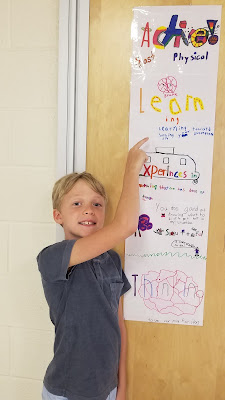A big THANK YOU to all my wonderful students for making the first month of ALERT a success! Here are some highlights of what we were working on in September.
Systems: Students were introduced to this year's theme of Systems and became familiar with system parts and how these parts interact. (Input, Output, Boundary, Elements) They used these terms and concepts to identify and label systems they come in contact with everyday and to create a list of generalizations that can be made about systems.
- Systems have parts that work together to create a whole.
- Systems interact.
- Parts of systems are interdependent and rely upon one another.
- A system may be influenced by another system.
We are highlighting our study of systems by looking at forensics and crime scene investigation. Students began their study by looking at fingerprint evidence and handwriting analysis.
Critical Thinking: Using the Children's Guide to Critical Thinking, the three types of thinkers were introduced. Students learned about Selfish Sam, Naive Nancy, and Fair-minded Fran. Using these characters as a conversation starter, we began to look at the importance of being a critical thinker, and traits that critical thinkers have.
Creative Thinking: Students have gotten familiar with our mascots of creativity, the Nerds! We use these particular mascots because no two are alike, they are colorful, fruity, and fun- just like creative thinking! Students explored our creative side by discussing and demonstrating the four keys to creative thinking. We began by taking a simple figure, looking at it from various perspectives (flexible thinking), brainstorming what it could become (fluency of ideas), choosing the idea like no one else's (originality), and filling in the details of our picture (elaboration)! These creative pieces became the covers of our ALERT binders reminding us to "think outside the box"!

Habits of Mind: Art Costa's Habits of Mind represent 16 traits that successful people can use when faced with a problem. Throughout the year, we will be focusing on building these individual traits in students. As an introduction, students looked at the habits collectively and became familiar with them playing our Habits of Mind matching game.

Morphic Thinking: We kicked off our Morphic Thinking morning routine where students warm-up with a spontaneous problem and boundary breaker. We will be including these weekly. A spontaneous problem is a brainstorming type problem to be solved in a specific amount of time and scored according to the number and creativity of responses generated. The point is to challenge students to be flexible thinkers, to elaborate on original ideas and to think fluently and creatively about a specific topic. A boundary breaker is a group experience which works toward creating a sense of community. Students gain an awareness of and respect for the opinion of others by the use of questions that go beyond superficial depth and have no right/wrong answers.
M^3 (Mentoring Mathematical Minds) Digging for Data: We had our commencing Digging for Data math lessons and students looked at both their rights and obligations as we embark. This math curriculum focuses heavily on discussion, defense of one's thinking, and writing about concepts.






















































